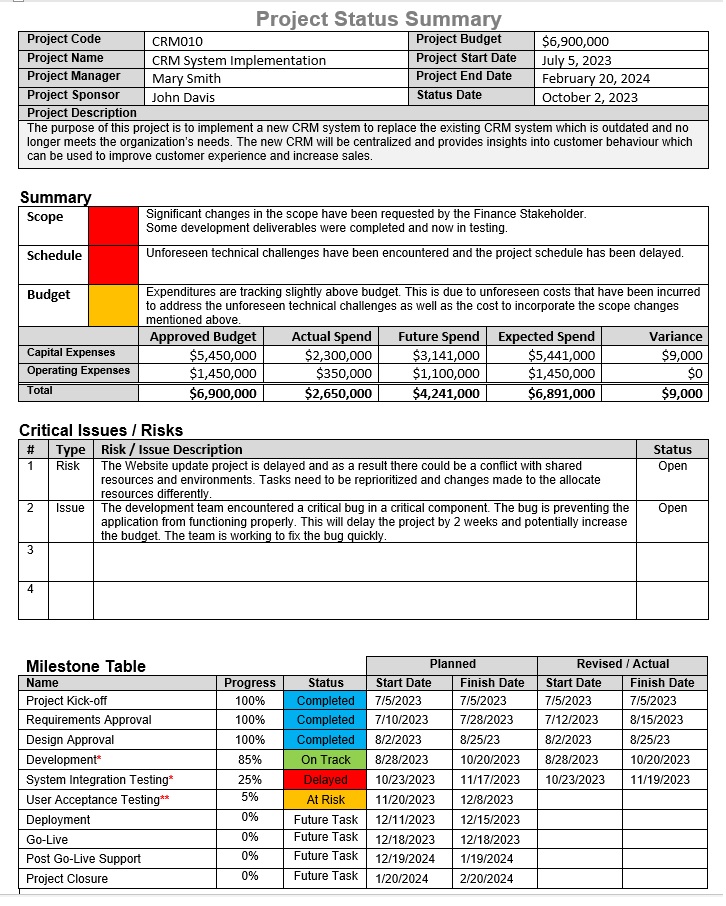
A project status summary is a concise overview of the current state of a project. It is typically used to communicate the project’s progress to stakeholders and to identify any potential risks or challenges. A well-written project status summary can help to keep everyone on the same page and ensure that the project is on track to meet its goals.
This blog post will provide you with a comprehensive guide on how to write an effective project status summary. We will cover everything from what to include in your summary to how to write it in a clear and concise way. We will also provide tips on how to make your summary more engaging for your stakeholders.
What to include in a project status summary
Your project status summary should typically include the following information:
- Overall project status: This should be a brief overview of the project’s progress, including whether it is on track to meet its schedule and budget.
- Key milestones: This should include a list of the project’s key milestones, along with their status and any anticipated delays.
- Risks and challenges: This should include a list of any risks or challenges that could impact the project’s success, along with plans to mitigate them.
- Next steps: This should include a list of the next steps that need to be taken in order to keep the project on track.
The importance of a well-written project status summary
A well-written project status summary is important for a number of reasons.
- It helps to keep everyone on the same page about the project’s progress. This can help to avoid misunderstandings and ensure that everyone is working towards the same goals.
- A well-written project status summary can help to identify potential risks and challenges early on. This allows project managers to take steps to mitigate these risks and challenges before they impact the project’s success.
- A well-written project status summary can help to build trust with stakeholders. By being open and honest about the project’s progress, project managers can show stakeholders that they are in control of the project and that they are committed to its success.
How to write an effective project status report
Here are some tips on how to write an effective project status summary:
- Start by identifying your audience. Who will be reading your summary? What information do they need to know?
- Gather the relevant information. This may include the project’s schedule, budget, risk register, and task list.
- Organize the information. Once you have gathered all of the relevant information, you need to organize it in a logical way. This will make your summary easier to read and understand.
- Write in a clear and concise style. Avoid using jargon and technical terms.
- Be honest and upfront. Don’t try to sugarcoat the project’s status. If there are any problems or challenges, be sure to identify them in your summary.
- Proofread your summary carefully. Before you send out your summary, be sure to proofread it carefully for any errors in grammar or spelling.
Tips for making your project status summary more engaging
Here are some tips on how to make your project status summary more engaging for your stakeholders:
- Use visuals. Visuals such as charts, graphs, and images can help to make your summary more visually appealing and easier to understand.
- Tell a story. Don’t just list facts and figures. Try to tell a story about the project’s progress. This will make your summary more interesting and engaging for your readers.
- Use positive language. Even if there are some challenges facing the project, try to use positive language in your summary. This will help to maintain a positive morale among your stakeholders.
Common mistakes to avoid when writing a project status summary
Here are some common mistakes to avoid when writing a project status summary:
- Not including all of the relevant information. Be sure to include all of the information that your stakeholders need to know, such as the project’s overall status, key milestones, risks and challenges, and next steps.
- Using too much jargon and technical terms. Avoid using jargon and technical terms that your stakeholders may not understand. If you must use technical terms, be sure to define them clearly.
- Being too negative. Don’t try to sugarcoat the project’s status. If there are any problems or challenges, be sure to identify them in your summary. However, try to focus on the positive aspects of the project
Conclusion
Writing an effective project status summary is an important skill for any project manager to have. By following the tips above, you can write a summary that will keep your stakeholders informed and engaged.
Free Download - Project Status Summary Report

